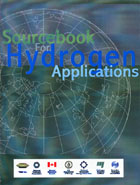
 Enter HyVIEW™
Enter HyVIEW™
Quick Links
| Hydrogen Safety Issues Hydrogen Safety Measures Comparisons Codes & Standards |
Hydrogen Safety Measures
The Safe Handling of Hydrogen
Like any fuel, the safe handling of hydrogen requires that the three necessary conditions for combustion be prevented. The wide flammability ranges of hydrogen imply that a mixture of hydrogen and air might ignite more easily than other fuels. Consequently, the following precautions must be adhered to:
- Hydrogen should not be mixed with air.
- Contact of hydrogen with potential ignition sources should be prevented.
- Purging of hydrogen systems should be performed with an inert gas such as nitrogen.
- Venting of hydrogen should be done according to standards and regulation.
- Because the hydrogen flame is invisible, special flame detectors are required.
Although hydrogen has a wide "detonatability" range, it is difficult to detonate a hydrogen vapor cloud in an open area without turbulent conditions. However, hydrogen should be handled with special care in confined, unvented areas. Various safety assessments are available to serve as a guide in setting up and designing hydrogen systems. For example, the Energy Technology Engineering Center (ETEC) conducted a safety assessment of a solar photovoltaic hydrogen generation, storage and dispensing system built and operated by "Clean Air Now!" at the Xerox Corporation facility in El Segundo, California. Other safety assessments were performed by Electrolyzer Corporation on the electrolytic production of hydrogen as well operational assessments for the Chicago Transit Authority and the British Columbia Transit for the Ballard bus trials.
For more information on handling hydrogen safely, you may consult: "Sourcebook for Hydrogen Applications" from TISEC Inc. and the Safety Standard for Hydrogen and Hydrogen Systems published by NASA.
Safety Analyses
Despite conformity to standards, accidents can occur, due to more complex chains of events than can be included in those standards. In the case of new projects, a proper safety assessment, involving the identification and the likelihood of potential failure modes and of mitigation procedures, can assist in identifying problem points and ensure that proper steps have been taken to address them. Safety analysis goes beyond verifying conformity to standards and anticipates accidents in order to improve the design of a demonstration project or a plant from the safety perspective. It analyses the probabilities of possible failure modes and estimates the physical consequences of an accidental spill or release. It looks at local, site-specific factors such as prevailing wind directions, and the location of buildings and public driveways. Consequence estimation is performed by mathematical or computational modeling. In general, a safety analysis proceeds in the following way:
- A risk analysis estimates the most likely failure modes.
- Environmental factors such as atmospheric and turbulence inducing conditions are identified.
- Dispersion models for gaseous or liquid hydrogen calculate the spread of hydrogen releases from likely release sites.
- Potential ignition sources are identified.
- An event tree finds the most likely consequence of ignition.
- Probabilities based on past experience with accidental spills or discharges are associated with the events.
- Thermal and overpressure levels are modeled as a function of distance to critical areas to estimate effects on human beings and structures.
This sequence of steps generates detailed information on the project itself and the potential effects on both human beings and structures. In many cases, it is carried out even if standards are available as a diligent attempt to identify potential problems and to complement the guidelines available in standards.

